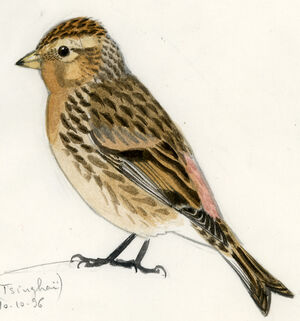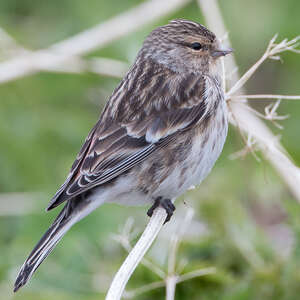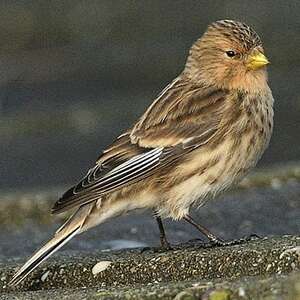Twite
Linaria flavirostris - Linotte à bec jaune
Identification
The Twite is a small passerine bird similar in appearance to its cousin, the Song Thrush, and distinguishing it, particularly juveniles in winter, is not obvious in the absence of adults. It is a rarity in France, to be looked for in winter on the coasts of the Channel, often in the company of the songthrush.
Unlike the latter, the Twite has a restricted sexual dimorphism. Only the rump is diagnostic, a pronounced pink in males, pale fawn in females.
The winter adult in fresh plumage, as observed in our country, has upper parts, from the beak to the tail, except for the rump, very striped with blackish brown. The wing coverts are brown, the middle ones slightly marked with beige at the tip. On the other hand, the large coverts are widely terminated with whitish beige, originating in a well-visible wing bar. The remiges and rectrices are brown. The inner primary remiges are narrowly bordered with white, which gives a visible white panel in the closed wing. The outer rectrices do likewise, resulting in white lines on each side of the tail.
The lower parts are white, tinged with russet on the sides and chest. The latter is well striped with blackish brown, the striping extending on the sides.
The head deserves attention as this justifies the French and Latin names of the species. Indeed, the beak is straw yellow with a black tip. The face (periphery of the eyes, sides of the beak, chin and throat) is rufous-fawn. The ear coverts are brown, lightly striped. The iris is very dark, almost black. The legs are dark.
At the end of the reproductive period, the plumage is very worn and has faded. It has become uniform because the stripes have faded a little. The bill has darkened, it has become grey on top with the base of the mandible yellowish.The juvenile is generally darker than the adults as its plumage is new. The face is less brightly coloured. The beak is pale. The wing shows two distinct beige-russet wing bars. This plumage is no longer suitable during the wintering in the south.
Subspecific information 9 subspecies
- Linaria flavirostris flavirostris (n Scandinavia and nw Russia)
- Linaria flavirostris pipilans (n Ireland and n Britain)
- Linaria flavirostris brevirostris (Turkey, the Caucasus and n Iran)
- Linaria flavirostris kirghizorum (n and c Kazakhstan)
- Linaria flavirostris korejevi (ne Kazakhstan to nw China)
- Linaria flavirostris altaica (sw Siberia, n and w Mongolia)
- Linaria flavirostris montanella (Kyrgyzstan, Tajikistan, n Afghanistan and nw Pakistan to nw China)
- Linaria flavirostris miniakensis (e Tibet and w China)
- Linaria flavirostris rufostrigata (w and s Tibet, n India and n Nepal)
Foreign names
- Linotte à bec jaune,
- Pardillo piquigualdo,
- pintarroxo-de-bico-amarelo,
- Berghänfling,
- sárgacsőrű kenderike,
- Frater,
- Fanello nordico,
- vinterhämpling,
- Bergirisk,
- stehlík horský,
- konopka žlutozobá,
- Bjergirisk,
- vuorihemppo,
- passerell becgroc,
- Lyngfinka,
- rzepołuch,
- kalnu ķeģis,
- severni repnik,
- Горная коноплянка,
- キバシヒワ,
- 黄嘴朱顶雀,
- vinterhämpling,
- 黃嘴朱頂雀,
Voice song and call
The male Twite sings on a perch or in a circular flight, with alternations of wing beats and glides. The song, similar to that of the Melodious Warbler, is gurgling and metallic, less melodic. Two main calls: a tioup-ioup-ioup, similar to that of the siskin and less harsh than that of the Melodious Warbler; and a touaa-iiit, nasal and almost shrill.
Habitat
The Twite is a mountain species that's nesting. It can be found at altitudes over 750 m and up to 5 000 m in the Himalayas.
Behaviour character trait
In winter, Twites are often seen in small groups of less than 10 individuals (in nearly 80% of the cases), but some flocks can reach up to 50 or 60 members.
They are sometimes mixed flocks composed of other granivorous birds, especially Song Thrushes as well as Yellowhammers.The Twite is a partially migratory species. If the UK birds are mostly sedentary, the significant Scandinavian population (100-150 000 pairs) winters from southern Sweden to Central Europe and across the English Channel. The best the Belgian and northern French coasts get is a few thousand birds. They don't venture further.
Flight
Dietfeeding habits
Reproduction nesting
Geographic range
The Twite is a Eurasian species. There are 8 subspecies recognized. The nominate subspecies, flavirostris, occupies the Western Scandinavian coast, extending eastwards into the beginning of the Russian coast. It winters around the North Sea, ranging as far as France and the Channel, around the Baltic Sea, extending to Central Europe (Czech Republic, Slovakia and even Hungary). The subspecies pipilans occupies Northern Ireland and Northern England, wintering in the south of England.
The subspecies brevirostris is Caucasian, extending southwards to Russia, northern Iran and northeast Turkey. This subspecies is a resident, only making altitudinal movements if necessary. The other subspecies are continental and Asian.
Threats - protection
IUCN conservation status
concern
in the Wild
threatened
evaluated
The Twite is not specifically threatened. Its distribution is wide and it is locally common. However, the British population has severely declined in recent decades, apparently due to habitat modification.
Sources of information
- IOC World Bird List (v15.1), Gill, F and D Donsker (Eds). 2025-12-07.
- Finches and Sparrows, Peter Clement
- Les passereaux d'Europe, tome 2, P. Géroudet, M. Cuisin
- Avibase, Lepage Denis
- Birds of the World, The Cornell Lab of Ornithology
- xeno-canto, Sharing bird sounds from around the world,
Other sources of interest
 Specification sheet created on
28/10/2023 by Daniel Le-Dantec
Specification sheet created on
28/10/2023 by Daniel Le-Dantec partially rewritten on 00/00/0000 by Jean François
Translation by AI Oiseaux.net
© 1996-2025 Oiseaux.net
- Accipitriformes
- Aegotheliformes
- Anseriformes
- Apodiformes
- Apterygiformes
- Bucerotiformes
- Caprimulgiformes
- Cariamiformes
- Casuariiformes
- Charadriiformes
- Ciconiiformes
- Coliiformes
- Columbiformes
- Coraciiformes
- Cuculiformes
- Eurypygiformes
- Falconiformes
- Galliformes
- Gaviiformes
- Gruiformes
- Leptosomiformes
- Mesitornithiformes
- Musophagiformes
- Nyctibiiformes
- Opisthocomiformes
- Otidiformes
- Passeriformes
- Pelecaniformes
- Phaethontiformes
- Phoenicopteriformes
- Piciformes
- Podargiformes
- Podicipediformes
- Procellariiformes
- Psittaciformes
- Pterocliformes
- Rheiformes
- Sphenisciformes
- Steatornithiformes
- Strigiformes
- Struthioniformes
- Suliformes
- Tinamiformes
- Trogoniformes































